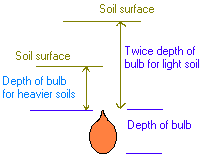Bulbs
Note:
I have included corms and rhizomes in this section as I consider them (rightly or wrongly), as food storage organs. I will refer to them all generally as bulbs.
After flowering, the foliage dies down and food is stored in the bulb through the dormant season. The following season new growth appears and the cycle will start again.
Bulbs are ideal for filling spaces in borders. If spring flowering bulbs are planted in amongst herbaceous shrubs, they will flower while the shrubs are still dormant, then, as they start to die back and the foliage starts to look untidy, the shrubs will have grown and will hide the untidy foliage.
Bulbs should not be considered as merely spring flowering. With careful planning you can have a year round display of colour.
When buying bulbs, make sure that the outer skin is intact and that the bulb feels firm. Any softness may indicate that the bulb is diseased or rotten inside.
Bulbs come in various sizes from the suppliers. The bigger the bulb, the more likely it is to flower for you. Some of the smaller bulbs may have been picked early by the suppliers and may not flower the first or even the second year until after planting. The larger bulbs are however more expensive than the smaller ones. Check what size bulb you are buying, particularly if you are buying by mail order.
Most bulbs like to be grown in groups. This also helps us by creating a solid block of colour. Try to avoid planting different variety bulbs in the same block as they do not always flower at the same time, unless you are particularly aiming at extending the display.
Type of Soil
Bulbs do not mind what type of soil they are planted in but it must be well drained or the bulbs will rot. If your soil is heavy or badly drained, dig it deeply and incorporate plenty of grit to help the drainage. It will also help if you put a layer of grit in the bottom of the planting hole for the bulbs to sit on.
Planting Times
Spring flowering bulbs such as Daffodils and Tulips and Crocus, should be planted in the late summer- early autumn.
Autumn and Summer flowering bulbs such as lilies and Gladioli should be planted in the spring or early summer.
Planting
 The depth that the bulb is planted is important. This depth depends upon the actual bulb type but it is generally twice the depth of the actual bulb in light soils and the same depth as the bulb in heavier soils. Most bulbs will not flower if they are not planted deep enough. It is also important that the bulb is planted the correct way up. Although bulbs will in fact 'turn' themselves in the soil, it can draw on their reserves of strength and prevent them from flowering.
The depth that the bulb is planted is important. This depth depends upon the actual bulb type but it is generally twice the depth of the actual bulb in light soils and the same depth as the bulb in heavier soils. Most bulbs will not flower if they are not planted deep enough. It is also important that the bulb is planted the correct way up. Although bulbs will in fact 'turn' themselves in the soil, it can draw on their reserves of strength and prevent them from flowering.
Some summer flowering bulbs like lilies, like to have their heads in full sunshine and their roots shaded. Planting beneath a low growing shrub will provide the necessary shade for the roots.
Maintenance
It is not enough to simply plant bulbs and leave them to get on with it. The flower that you see in the first year that you planted the bulb is the results of the work of the growers. Any further flowers will depend upon You, and you will have to do what he did to achieve success.
The bulbs will need a plentiful supply of fertiliser, particularly after flowering. This is the time that the bulb builds up its reserves for the following years flower. Remove any dead flower heads immediately after the flowers have faded. This will ensure that the bulb does not waste its strength in trying to produce a seed head. Make sure that there is plenty of Potash in the ground at this time and give an extra feed if needed. A liquid feed is usually better as it will be taken up by the plant quicker.
Many gardeners hate the sight of the untidy foliage after the flowers have faded, and cut this off or tie them up in bundles. This is the wrong thing to do. The foliage is how the plant gets its energy (through photosynthesis), and must be left to die back naturally so that the bulb can build up its reserves. If you cut the foliage off too early the bulb will get weaker and weaker and finally give up and die.
Once the foliage has turned yellow and died down naturally (usually 6-8 weeks after flowering) give the ground a mulch of well rotted compost or manure.
Some of the more tender bulbs like Gladioli and Dahlias will have to be lifted and stored to prevent frost damage. Dig them up, clean any soil off them (wash if necessary) and let them dry. Put into storage ready for replanting in the spring. Some gardeners prefer to dust them with a fungicide such as sulphur, to prevent any diseases, before storing them in wooden boxes in a frost free place over the winter.
© copyright 1999, P. A. Owen

